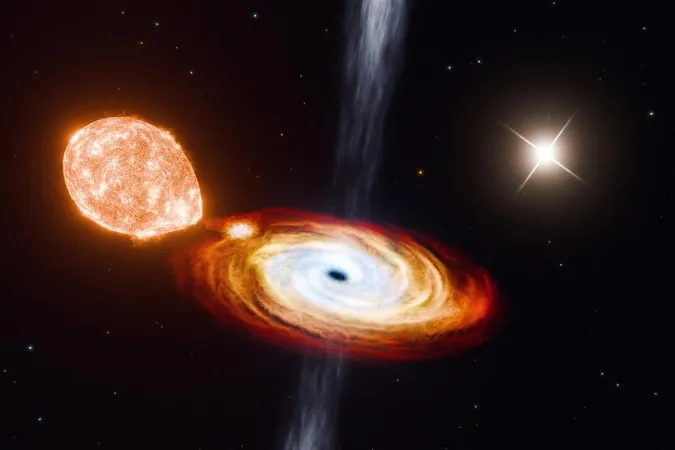
Astronomers Discover a New Type of Black Hole Formation—A Gentle Beginning!
2024-10-29
Author: Siti
Introduction
In a groundbreaking revelation, astronomers have challenged the long-held belief that black holes—a dense cluster of matter with gravitational pull so strong that not even light can escape—are predominantly birthed through violent supernova explosions of dying stars. Instead, recent findings suggest that some black holes may form through a more peaceful process.
Discovery of a Unique Black Hole
A remarkable discovery has led researchers to identify a black hole that appears to have originated from the collapse of a massive star's core without undergoing a catastrophic explosion. This black hole is currently gravitationally bound to not one, but two ordinary stars, a first in the history of black hole observations.
Location and Characteristics
Located roughly 7,800 light-years away in the constellation Cygnus, this intriguing system includes a black hole designated as V404 Cygni, which has been a subject of extensive study since its confirmation back in 1992. Previously thought to be in a binary system with just one companion star, new data from the European Space Agency’s Gaia space observatory has unveiled its true nature as a triple system.
Mass and Accretion Process
The studied black hole has a mass estimated at about nine times that of our sun and is currently in the process of accreting material from one of its companion stars—one that is about 70% the mass of our sun. This star is in close proximity to the black hole, revolving around it every six and a half days and at a distance about one-seventh that separating the Earth from the sun. Interestingly, as it ages, this companion star has swollen during its 'red giant' phase, making it an attractive target for the black hole's gravitational embrace.
The Second Companion Star
But that’s not all! A second companion star, roughly 1.2 times more massive than the sun, also joins this cosmic dance, orbiting the trio at a much greater distance, taking 70,000 years to complete a single orbit.
The Gentle Formation Hypothesis
What stands out in this astronomical discovery is the concept of 'gentle' black hole formation. The researchers propose that if the black hole had been born from an explosive supernova, the forces involved would have torn the triple system apart. Instead, they introduced the notion of 'failed supernova' events—where a large star collapses inward without the violent expulsion typically associated with supernova explosions. Kevin Burdge, an astronomer at MIT and the study's lead author, described this process as 'dramatic and awesome' while still remaining 'gentle' due to the lack of expelled matter.
A Long History of Formation
The members of this unique triple system are estimated to have formed around 4 billion years ago from ordinary stars, suggesting a rather tranquil history leading to the birth of this black hole. Caltech astronomer Kareem El-Badry, a co-author of the study, pointed out the implications of this discovery: it indicates that not all black holes emerge with a substantial 'kick,' thereby reinforcing the significance of the gentle implosion theory.
Future Implications
As this black hole continues to consume its nearest star companion, the fate of this triple system hangs in the balance. The ongoing consumption may unravel the existence of further binary systems comprised of a black hole and a regular star, hinting that many might share origins from similar triple setups.
Conclusion
This study, published in the journal Nature, unveils a new chapter in our understanding of black holes and their formation, and raises exciting questions about the dynamic relationships between these cosmic entities. Could this understanding reshape our knowledge of black hole evolution? Only time—and further research—will tell!


 Brasil (PT)
Brasil (PT)
 Canada (EN)
Canada (EN)
 Chile (ES)
Chile (ES)
 Česko (CS)
Česko (CS)
 대한민국 (KO)
대한민국 (KO)
 España (ES)
España (ES)
 France (FR)
France (FR)
 Hong Kong (EN)
Hong Kong (EN)
 Italia (IT)
Italia (IT)
 日本 (JA)
日本 (JA)
 Magyarország (HU)
Magyarország (HU)
 Norge (NO)
Norge (NO)
 Polska (PL)
Polska (PL)
 Schweiz (DE)
Schweiz (DE)
 Singapore (EN)
Singapore (EN)
 Sverige (SV)
Sverige (SV)
 Suomi (FI)
Suomi (FI)
 Türkiye (TR)
Türkiye (TR)
 الإمارات العربية المتحدة (AR)
الإمارات العربية المتحدة (AR)